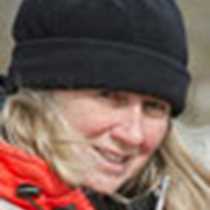Storfjorden & Habenichtbutka, Edgeøya
There is no darkness at these latitudes, nothing that would qualify as night during this season of the year. The hands on the clock might indicate that the time for slumber is nigh, but the body denies this signal and feels as energetic at midnight as it does in mid-afternoon. Without some assistance from Mother Nature we could easily find ourselves running on empty in not too many days. Thus, when fog wafted around our vessel last evening, we took the hint and slept away the night while we were transported around the tip of Spitsbergen Island.
As the alarm chimed its morning tones the mist lay behind us like a comforter tossed aside. Sorkappøya was a mass of jagged peaks iced with snow that trickled from their flanks like thin icing on a chocolate cupcake. A gauzy veil of clouds prevented the sky from being a clear deep blue. Fata morgana, the superior mirage distorted the distant shoreline stretching it into non-existent peaks and creating towers of floating bergy-bits. A long string of jumbled ice rose and fell with the gentle roll of the sea.
Searching eyes eagerly scanned each floe looking for tell tale signs of the Arctic’s famous polar bear. It did not take long. First one was spotted and shortly thereafter another. Both had failed to notice that, in our world, it was time to be up and about. Like sleepy teens, they slumbered on, paying little heed to our presence.
Fog washed back around us and we ventured away from the ice crossing the open waters of Storfjorden, seeking visibility. Breast-stroking harp seals crossed our path, their strange swimming motion lifting head and shoulders high above the surface. Little auks frantically flapped like bumblebees and guillemots gathered in rafts on the sea. Edgeøya appeared to the east and with it a streamer of rotting ice like a giant raft towed by an iceberg barge. Unlike the morning’s lumpy ice, this strange drifting floe had little elevation anywhere along its lengthy plane. Thus a tiny moving dot drew us ever nearer.
Yes, another bear, but something appeared to be amiss. Stories circulated as we approached and our minds synthesized the images presented to our eyes. There was more than just one bear but what was it hiding? Was it protecting a cub? The behavior certainly indicated familiarity or possessiveness of whatever was hidden behind this good sized form. Little by little we were able to construct a second bear, close to the same size as the first. But was it alive? There was not even a flicker of breath visible. What had happened here? Had there been a fatal fight? Had one bear opportunistically stumbled upon an ill or aged bear? We watched and waited. We fought with emotions within ourselves and rationalized the behaviors. What was the end of the story? Another sleeping bear! Naptime over, the second bear slowly shook itself awake while the sentry sibling snuggled down for forty winks.
The shoreline was nearby, its doleritic surface fractured into massive stepping stones, heaved by frost and scoured by glaciers. Habenichtbutka had all of the elements needed to sustain the life of man. Its harbor was perfect protection for sailing or whaling boats in generations past and for our Zodiac’s today (although we needed little protection for the weather was gorgeous and calm).
Fresh water lakes lured loons and long-tailed ducks to nest on tiny rocky islets. Geese honked nearby. Svalbard caribou roamed about the tundra flats and we did too, exploring remnants left by English whalers and Russian Pomor trappers. We walked in the half inch high birch forest and examined mounds of miniscule purple saxifrage or pink moss campion. All too soon the clock tolled once again and we were enticed back on board by the promise of refreshments.



